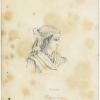‘Head of Brenese Peasant’
Page featuring an engraving by ‘W. J. M.’ (made after a drawing by Arthur Evans), captioned ‘Head of Brenese Peasant’, published in Arthur J. Evans, Through Bosnia and the Herzegóvina on Foot during the Insurrection, August and September 1875 (London, 1876), p.389.
Artist: ‘W. J. M.’ (initials of engraver), after an original drawing [1941.8.177] by Arthur John Evans
Date of publication: 1876
Continent: Europe
Geographical area: Southern Europe
Country: Croatia
Region/Place: Dubrovnik
Cultural group: European Croat
Format: Woodcut engraving
Page size: 234 x 141 mm
Acquisition: Henry Balfour. Bequeathed February 1939
***
Research notes: It has been identified by Philip Grover that this woodcut engraving by ‘W. J. M.’ (initials of unidentified engraver) was based on an original drawing [1941.8.177] by Arthur John Evans, being the portrait of a peasant from Breno, Croatia, seen in the market place of Dubrovnik. It was published in Evans’ account of his journey, Through Bosnia and the Herzegóvina on Foot during the Insurrection, August and September 1875 (London, 1876), p.389, printed with the caption ‘Head of Brenese Peasant’. Evans recorded in the volume: ‘At the present day the Canalese peasants who inhabit the district about the site of ancient Epidaurus differ so essentially in fact and form from the surrounding Sclavonic races whose language they speak, and are so Oriental in their appearance, that Appendini, the historian of Ragusa, has recorded an opinion that they are nothing else than descendants of the old Phoenician colonists of this coast. He would be indeed a bold man who should accept this theory without reserve, but I can bear the most emphatic testimony to the existence of a strikingly Oriental type in this neighbourhood. In Ragusa Vecchia itself the countenances struck me as of ordinary Serbian or Italian types. But in the market-place of Ragusa I noticed three peasant women whose faces bespoke, as plainly as faces can speak, an entirely different origin. On enquiring whence they came I found them to be native of the Golfo di Breno, a cove about three miles distant from the site of Epidaurus. The faces were strikingly alike. They were long and narrow, the nose thin and long, very finely chiselled, and inclined to be aquiline, they eyes black, and their tresses to match. The big gold beads of her necklace, and the brilliant red and orange kerchief that coifs her head, are the same as those worn by her Serbo-Italian neighbours; but, assuredly, the face of the girl I sketched is that of a Syrian rather than a Serbian beauty!’: Through Bosnia and the Herzegóvina on Foot, pp.388–389. The same engraving was earlier published in the British illustrated newspaper The Graphic, 9 October 1875, p.348, captioned at bottom of the page ‘3. A Brenese, sketched near Ragusa.’ Note that Ragusa is the German name for Dubrovnik, Croatia.

